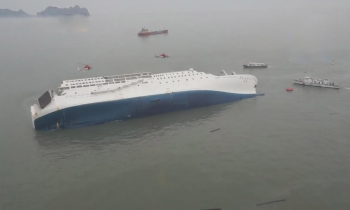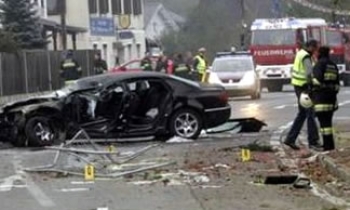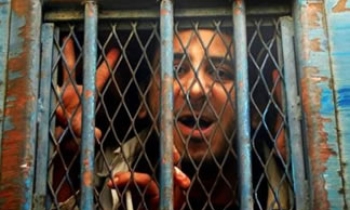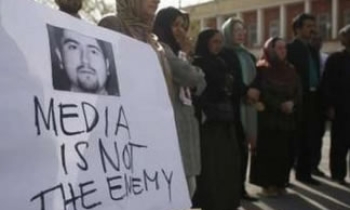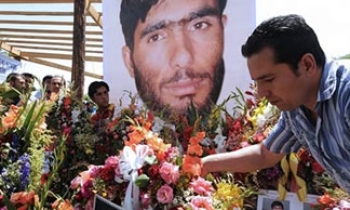The front pages of more than 20 newspapers today ran a photo of a naked, emaciated American clinging to life as rescuers carried him from his home.
Editors say the startling image, showing a man being rescued in New Orleans 16 days after Hurricane Katrina, created discussions in their newsrooms but ultimately carried enough news value to make it worth publishing.

The photo, by Orange County Register photographer Bruce Chambers, was distributed by the Associated Press and Knight Ridder/Tribune.
The Register identified the thin, unconscious man in the picture as Edgar Hollingsworth, age 74, and said he was taken to a hospital and was expected to survive.
In the picture, National Guard Spc. Manuel Ramos gently lifts Hollinsgworth, who is naked, off a stretcher while other rescuers assist with an breathing mask and an IV bag. The image is centered in front of a tidy front porch, with mailboxes and a potted plant.
"It's just one of those things - right place, right time," says Chambers, who was embedded with California Task Force 5, a search and rescue team from Orange County.
Marcia Prouse, director of photography at the Register, says editors discussed such factors as whether Hollingsworth survived (he did) and whether the picture showed anyone from Orange County (it didn't). Ultimately, they ran it on the front page.
Editors considered the man's nudity, especially given the conservative readership of the Register, but Prouse says the photo didn't show anything outside the bounds of taste.
"This man's story needs to be told. He's an important symbol of the hurricane," Prouse says. Even the setting of the front porch contributed to the man's humanity. "It's anybody's father or grandfather," she says.
At the Miami Herald, several editors discussed whether the photo belonged on the front page and executive editor Tom Fiedler made the final call that it did, according to Luis Rios, the Herald's director of photography.
"This is one photo that really captured, in a dignified way, someone who lived through Katrina, through the embarrassment of the response, and was carried out," Rios says.
San Antonio Express-News photo editor Rick McFarland says his paper debated whether to crop the photo, but decided to run it in full on the front page.
"The main concern was the fact that he didn't have any clothes on," McFarland says. "I thought that the news value of the picture outweighed that." McFarland also says that if the man had died soon after the picture was taken, the paper probably would not have run it.
Some papers published other images from Chambers' series of photos, including a tighter shot that shows Hollingsworth's face as medics care for him. Editors at the Providence Journal, for example, chose to run the close-up image on their front page.
Chambers, speaking to PDN after returning to California this afternoon, says his photo immediately reminded him Michelangelo's Pietà, a sculpture that depicts Mary cradling the crucified body of Jesus.
"I'm not saying I made a piece of art. It just happened that way," Chambers says.
Chambers shot the image on the afternoon of his last day traveling with the task force. He was working on a profile of a logistics crew when a radio call came in about a man in need of medical attention about two miles away. Chambers says he hopped on the tailgate of a truck and rode with rescuers to the scene.
At first, Chambers stayed in the truck after he saw a National Guard soldier scolding an official National Guard photographer for intruding on the scene. But when a TV crew showed up - apparently after hearing the same radio call - Chambers was able to get in closer for the shots of the rescue team at work.
Chambers transmitted the photo to the Register a short time later using a cellular modem.
Register Reporter Keith Sharon was also traveling with the search-and-rescue task force and wrote a story about the rescue. The task force had been sidelined for four days in Austin before being given clearance to enter the hurricane area, and Hollingsworth was the first person they rescued. Sharon's story records the elation rescuers felt in being able to help someone.
If the task force hadn't reached Hollingsworth, he would have died within 24 hours, according to the Register, which quoted the doctor who treated him at the scene.
At the Register, Chambers is a roving photographer who is often dispatched to cover breaking news. When not on assignment, he goes off looking for features and photo stories. He has been a news photographer for 26 years, including 15 years with the Register, and was nominated for a Pulitzer Prize in 1985 for his coverage of the 1984 Olympics.
He says being embedded with the task force has helped him build rapport with emergency workers, which will help him with his work back in Orange County. "When they see me out there, they're going to treat me well," he says.
Despite capturing some good pictures, Chambers describes his last two weeks on hurricane duty as "very frustrating," especially being with the rescue team when they were delayed in Austin.
"I think people died because people couldn't get their act together," he says. But he had kind words for the members of the task force that permitted the two journalists to accompany them. "They went out on a limb for us," Chambers says. "They're the heroes."
Daryl Lang is the news editor for Photo District News (PDN).




